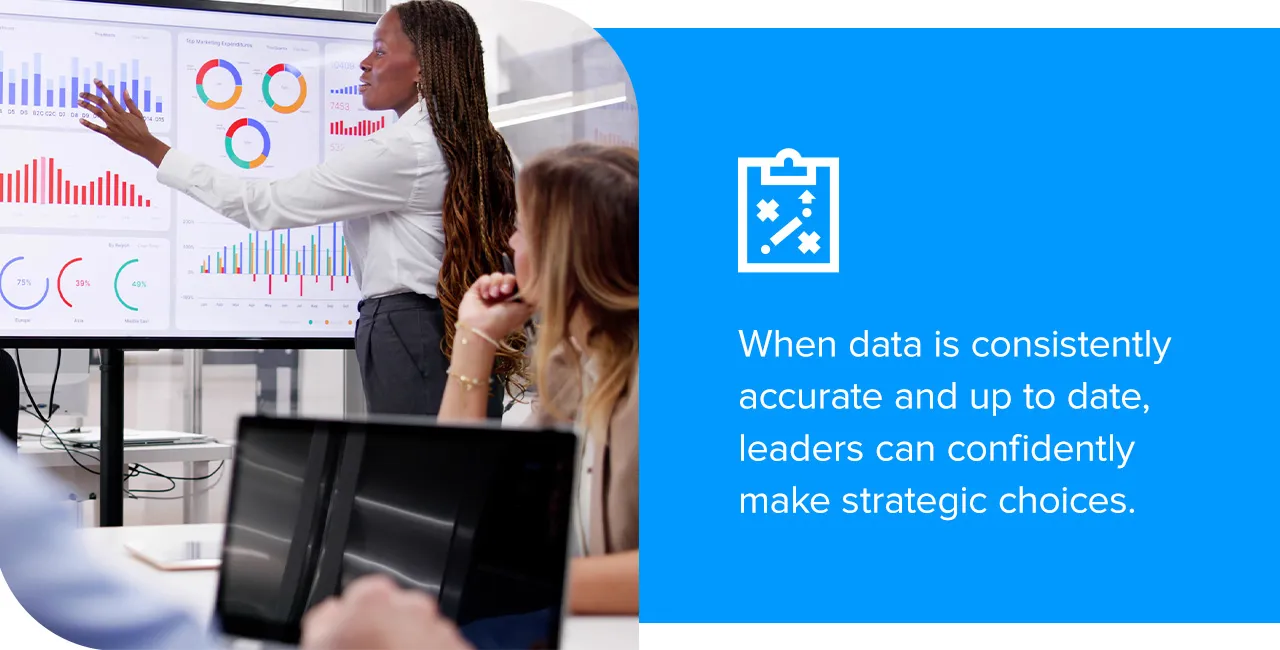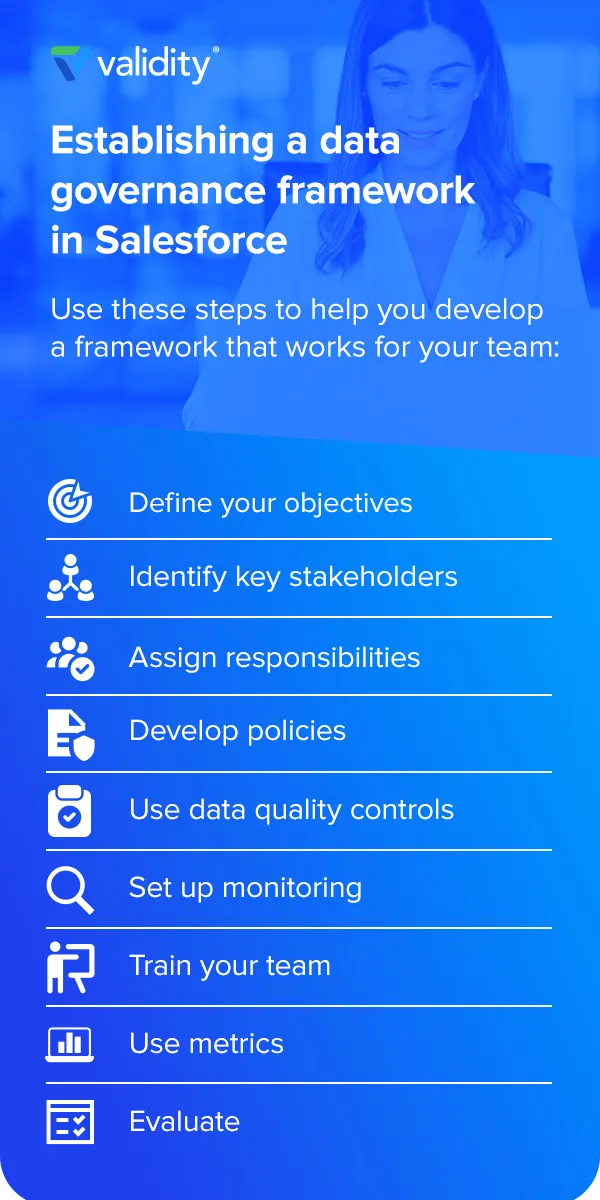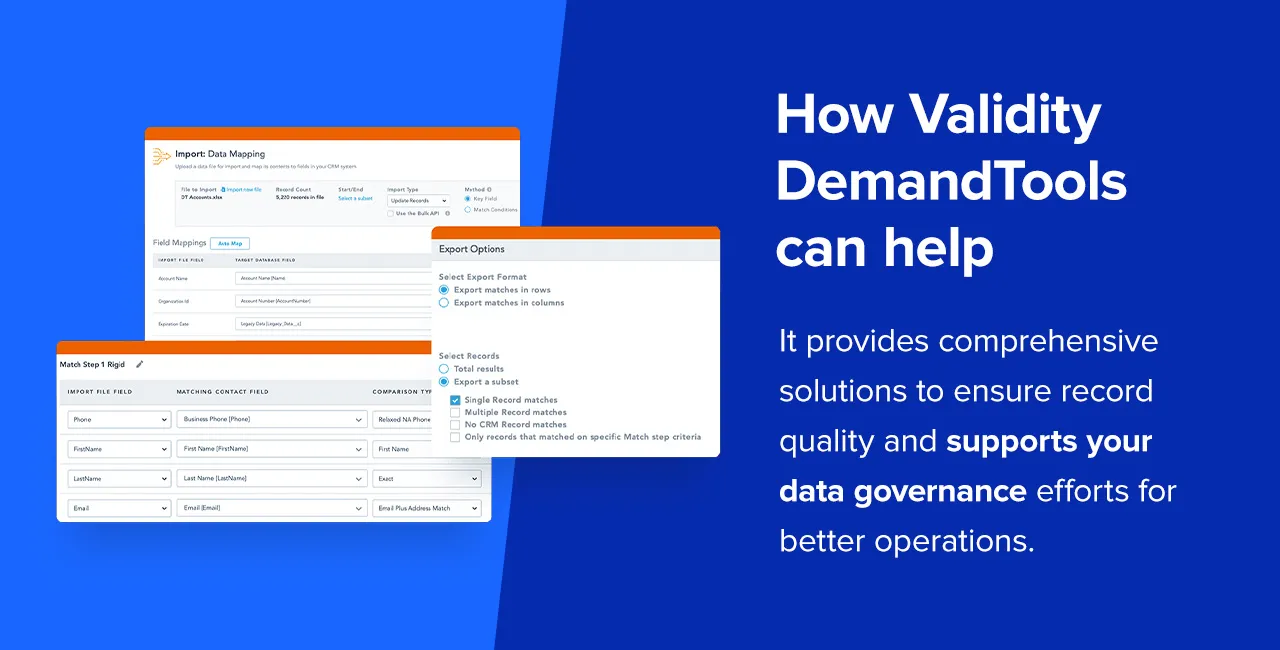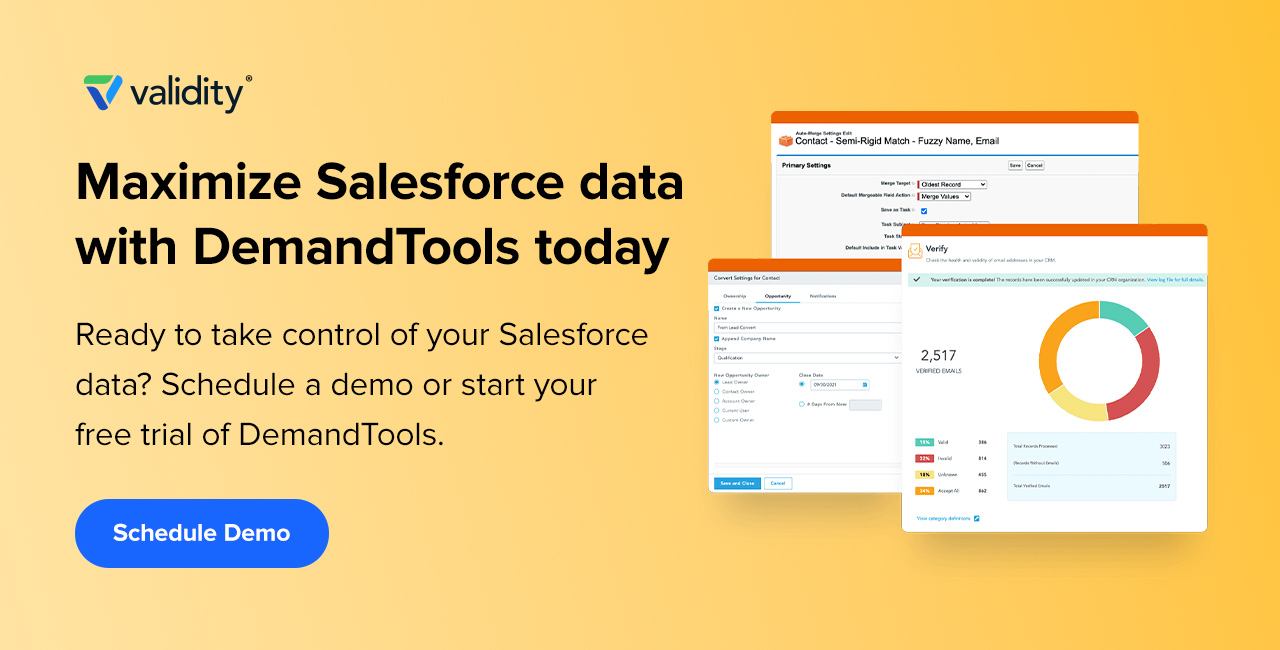
Salesforce offers a centralized interface that simplifies customer relationship management (CRM). However, keeping track of all customer, account, and lead insights this system collects can take significant time and effort without proper CRM data governance practices.
Managing information errors, duplicates, and inconsistencies is a full-time job. Proactively handling these issues is where strong Salesforce data governance comes in.
A solid data governance strategy and ongoing support make your Salesforce records more effective. The right processes and policies will keep data clean, compliant, and reliable. And with a good handle on your insights, your teams can make better decisions and push the business forward.
Following a few basic tips and tools to maintain high-quality information can help your business maximize its Salesforce investment. Let’s take a look at data governance in Salesforce and how it shapes your operation.
What is data governance in Salesforce?
Data governance for Salesforce means monitoring your records for accuracy and security. Effective data use boosts your Salesforce information’s integrity, security, and consistency. Without proper record control, you can have inaccurate, unhelpful insights, and potential non-compliance with regulations.
Effective data governance in Salesforce involves several key components:
- Ownership: Who handles each dataset?
- Quality: How do you maintain accurate, up to date, and complete data?
- Compliance: Does your data use align with regional consumer data protection laws and extensive industry regulations?
- Security: How do you protect data from breaches or unauthorized access?
The stronger your Salesforce record governance, the better your insights will be. Effective data governance unlocks your Salesforce potential.
How CRM data governance impacts decision-making
Data governance is about more than just managing your information. The way you handle your records directly impacts your organization’s success. When data is consistently accurate and up to date, leaders can confidently make strategic choices. Good data governance in Salesforce helps identify trends, find issues early and provide insights into market dynamics. With a clear understanding of the landscape, your team can up their planning and risk assessment. Better data governance means empowering your organization to make smarter decisions, boosting business performance.
Key principles of Salesforce data governance
Effective Salesforce data governance is built on key principles that create a strong foundation for managing and using information. A better setup means improved data compliance, security, and decision-making.
Two of the most critical principles include data ownership and compliance. These principles ensure your data is well-controlled and aligned with regulatory standards.
The importance of data ownership
Before you can begin using data, you need to assign ownership to improve data accountability. These could be people, teams, or entire departments. Each owner is responsible for maintaining, updating, and securing their data. This accountability prevents information from slipping through the cracks or causing responsibility confusion.
Additionally, establishing data ownership improves your information quality. Specific data owners mean people are more invested in keeping their records up to date and accurate. They see the direct results of their responsibility and can take pride in the quality of their work. Clear ownership will also smooth out communication. If anyone has questions about data or issues, your organization can contact them and see who’s responsible for each area. Your business can benefit from faster resolutions and fewer misunderstandings.
Data ownership also plays a critical role in regulation compliance. Owners managing smaller datasets are more aware of relevant regulatory guidelines. With a narrower focus, owners can better manage compliance. This proactive approach also ensures data is handled according to internal standards.
Monitoring and compliance
Monitoring and compliance audits are essential elements of Salesforce data governance to ensure you adhere to necessary rules, such as the Data Privacy Framework or General Data Protection Regulations (GDPR). Additionally, regular checks will catch any problems early. This strategy prevents breaches or regulatory violations.
Schedule audits regularly to make sure everything checks out. Look for the following:
- Unauthorized access
- Regulation compliance
- Data accuracy
- Data completeness
Compliance checks are vital for industries with strict data protection laws, like health care, finance, and education. Consistent monitoring helps you avoid fines and maintain consumer trust. Salesforce offers several tools to track user activities and support audits. But you can also use third-party solutions like Validity DemandTools to more effectively remove duplicates and delete old information from the system, improving your compliance practices.
Establishing a data governance framework in Salesforce
Nailing those Salesforce data governance best practices starts with a solid foundation. You need to establish a well-defined framework to support quality decision-making, compliance, and data management. Use these steps to help you develop a framework that works for your team:
- Define your objectives: What do you want to achieve with your data governance in Salesforce? A clear path keeps you on track and motivated. Common goals include ensuring security, improving information quality, and staying compliant. Find the specific gaps you want to fill and make them a driving force in a good data governance plan.
- Identify key stakeholders: Data governance depends on collaboration. Identify the stakeholders you want to be responsible for Salesforce data governance. This might be department heads, IT teams, or Salesforce administrators. Having a data governance committee lets the right people coordinate your efforts.
- Assign responsibilities: Once you’ve assigned stakeholders, lay out responsibilities. Put people in charge of data ownership, quality, monitoring, and compliance. Include a decision-making hierarchy. You want everyone to know their responsibilities and who to turn to when they need help.
- Develop policies: Your data governance framework needs documented policies. Have them cover record entry standards, retention, and access controls. Make sure everyone knows and understands relevant procedures. Consistency and education are key to protecting your data.
- Use data quality controls: Data quality is everything to your organization. It supports good decision-making and keeps your records accurate. Set up controls to protect information completeness, accuracy, and consistency. Salesforce and third-party tools let you maintain the quality of your data. Use duplicate management tools, validation rules, and regular audits to boost quality.
- Set up monitoring: You also need to carefully oversee your data. Regular monitoring keeps the information framework solid. Track usage, set up audits, and check regulation compliance.
- Train your team: Even the best frameworks need some training. Make sure all Salesforce users understand CRM data governance and how to protect it. Provide ongoing training and other resources for your team. With good support, they’ll stay on top of your information.
- Use metrics: You need clear metrics to improve your results. Monitor data quality scores, data errors, and cost savings to get critical insights. With this information, your team can set clear goals and track their progress toward success.
- Evaluate: Data governance is forever. With new threats appearing and technology shifting rapidly, you need to set a schedule for regular system updates. What’s working in your framework? Where are the gaps? Set bi-annual or annual updates to ensure you’re keeping your data governance proactive.
Implementing data quality standards
Data quality standards are also going to support Salesforce governance best practices. High-quality data gives you factual reporting and reliable insights. Conversely, making decisions on incomplete or incorrect results can interfere with your success.
You need to define what “high-quality data” means for your organization. Having clear criteria will help you get the best insights for the job. Your record quality depends on the following:
- Accuracy: Data has to be valid, error-free, and up to date to be useful. Accuracy is one of the most essential elements of high data quality standards.
- Completeness: Do you have all the data you need? Incomplete records and missing fields can cause inaccurate analyses and missed insights.
- Consistency: Your Salesforce insights should be consistent across the environment. All your values, formats, and structures need to be uniform across all departments and systems.
- Recency: Data has to be current and regularly updated. Outdated records might give you the wrong results, leading to poor decisions or wasted resources.
- Relevance: You only need relevant data. Redundant or unnecessary information clutters a Salesforce org. This clutter makes finding useful information harder and more time-consuming.
Techniques for maintaining high-quality data
Using the proper techniques makes data governance easier. Once you have your quality criteria, you need to apply them correctly. Use these methods to help you ensure high-quality insights:
- Data entry validation: Use Salesforce or a third-party solution to prevent errors in the system during data entry. Enforce information entry standards to set specific formats or prevent blank fields. Stopping errors at entry points lowers the chances of errors spreading through your system.
- Duplicate management: Duplicate records can clutter up your Salesforce system. There are many tools that an detect and merge duplicates automatically.
- Data audits: Regular audits clear out issues that can compromise data quality. Use automated data audits to find and address problems early, promoting accurate insights.
- Data cleansing: Regularly cleanse your data to remove outdated or irrelevant records. Information cleansing tools spruce up old records, keeping everything accurate. Use automated cleansing tools to maintain your database without pulling away more manual resources.
- Ongoing education: Automated tools can provide support, but your team needs to know how to use them. Provide ongoing training and education on best practices for data entry, maintenance and Salesforce tools to maintain information quality.
Data standardization
Data standardization is at the heart of your data quality. Consistent records across an organization simplify analysis and efficiency. With non-standardization, you can get fragmented, difficult-to-understand insights. Avoid inefficiencies and errors with effective standardization techniques.
Data standardization is how you make your information uniform across your organization. Use consistent values, formats, and classifications to prevent confusion and maximize insight accuracy. For example, do addresses follow the same structure? Do you have consistent product names across all records? Standardizing data makes it more accurate, easier to read and highly useful.
Standardizing your data in Salesforce involves the following:
- Picklists: Picklists let you set predefined options for fields. You can set consistent values for data, making it easier to categorize.
- Field formatting rules: Salesforce also lets you set specific formatting rules for fields. Establish rules around postal codes and phone numbers to make sure all data follows the same structure.
- Naming conventions: Setting consistent naming for data makes it easier to find. Consistent naming across accounts and campaigns reduces confusion when identifying records.
- Automated tools: Finally, automated tools can make standardization simple. Mass modification lets you apply updates uniformly, saving time and reducing errors.
The role of data management tools in Salesforce data governance
Data management tools are essential for enhancing Salesforce privacy and data governance success. These tools help ensure information accuracy, consistency, and security, keeping you compliant and improving insight quality. Automated tasks like data deduplication, cleansing, and validation reduce errors while making the process more efficient.
Additionally, Salesforce data management tools can improve auditing and reporting. They enable real-time data monitoring, helping you catch and prevent issues. With tools keeping everything consistent, you’ll also see better communication between teams. Consistent information improves collaboration and understanding for more reliable results. These tools easily integrate with existing processes, minimizing downtime. Data management tools create a strong framework that supports the rest of your operation.
How Validity DemandTools can help with Salesforce data governance
Validity DemandTools can transform how you govern data in Salesforce. It provides comprehensive solutions to ensure record quality and supports your data governance efforts for better operations. Your business can enjoy features like:
- Data deduplication: DemandTools lets you flag and merge identical and similar records through a series of sophisticated matching algorithms. The solution automatically spots and combines duplicates. You can use it to prevent data fragmentation and keep information accurate.
- Data cleansing: The data cleansing features standardize your formats and correct errors. These features keep record quality up for better decision-making.
- Automation: Automated updates, scheduled jobs, and notifications within DemandTools remove the burden from data managers, giving them time to focus on other important jobs.
- Data consistency: Your Salesforce information often comes from different sources. Manual inputs, bulk imports, and third-party integrations can create a complex ecosystem. With all that data coming in, you might see duplicates and formatting errors. DemandTools standardizes every insight, preventing these problems.
- Flexibility: Whatever your data needs and volume, DemandTools can handle them. It’s a highly flexible, scalable solution for your CRM. Save custom processes and automate tasks to manage everything without wasting time.
Maintaining good data governance in Salesforce on your own can be challenging. If you want to maximize your CRM potential, Validity can help. The DemandTools platform is the ultimate data governance solution for CRM needs. It’s designed to help you manage, maintain, and cleanse Salesforce information easily.
Struggling with duplicate records or outdated information? DemandTools will streamline your processes, and your team will get reliable insights to improve efficiency with our expert support.
Ready to take control of your Salesforce data? Schedule a demo of DemandTools today.



